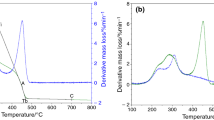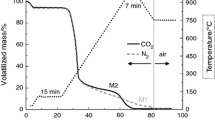Abstract
Most of the agricultural industries generate daily waste, which due to toxicity or quantity deserve special attention. The cassava starch produces a significant quantity of residues, which must be rationally used for minimizing the environmental impact of the agricultural activities. The present study aims to enhance the use of this solid residue. We analyzed the cassava bagasse by means of the following techniques: thermogravimetric analysis (TG) and differential scanning calorimeters (DSC). It was addressed the effects of operational conditions (final temperature, heating rate, atmosphere, air flow and size of particles). The cassava bagasse samples collected in a cooperative production facility in Paraty-RJ were characterized using TGA/DSC in order to describe the thermal behavior of these residues. The DOE methodology proposed by Taguchi was used to analyze and cover a broader range of operational parameters. The most influential variables were identified for the process of heat production using DOE technique. These variables provide the best combination for heat flux with residence time of 30 min, air flow of 50 mL min−1, particle size sieved to 0.42–0.71 mm and heating rate of 25 °C min−1. The main parameters related with the thermal decomposition, effective activation energy and decomposition mechanism were newly determined using thermal techniques analysis methods (TGA/DSC) for the cassava residue.
Graphic abstract










Similar content being viewed by others
References
Hu G, Chen J, Gao J. Preparation and characteristics of oxidized potato starch films. Carbohydr Polym. 2009;76:291–8. https://doi.org/10.1016/j.carbpol.2008.10.032.
Shah U, Naqash F, Gani A, Masoodi FA. Art and science behind modified starch edible films and coatings: a review. Compr Rev Food Sci Food Saf. 2016;15:568–80.
de SouzaYes Fernandes D, dos Santos TPR, Fernandes AM, Leonel M. Harvest time optimization leads to the production of native cassava starches with different properties. Int J Biol Macromol. 2019;132:710–21. https://doi.org/10.1016/j.ijbiomac.2019.03.245.
Pandey A, Soccol CR, Nigam P, Soccol V, Vanderberghe LPS, Mohan R. Biotechnological potential of agro-industrial residues II: Cassava bagasse. Bioresourse Technol. 2000;74:81–7.
Ki OL, Kurniawan A, Lin CX, Ju YH, Ismadji S. Bio-oil from cassava peel: a potential renewable energy source. Bioresour Technol. 2013;145:157–61. https://doi.org/10.1016/j.biortech.2013.01.122.
Oluwasina OO, Olaleye FK, Olusegun SJ, Oluwasina OO, Mohallem NDS. Influence of oxidized starch on physicomechanical, thermal properties, and atomic force micrographs of cassava starch bioplastic film. Int J Biol Macromol. 2019;135:282–93. https://doi.org/10.1016/j.ijbiomac.2019.05.150.
Gazzotti S, Rampazzo R, Hakkarainen M, Bussini D, Ortenzi MA, Farina H, et al. Cellulose nanofibrils as reinforcing agents for PLA-based nanocomposites: an in situ approach. Compos Sci Technol. 2019;171:94–102.
Qin Y, Liu Y, Yong H, Liu J, Zhang X, Liu J. Preparation and characterization of active and intelligent packaging films based on cassava starch and anthocyanins from Lycium ruthenicum Murr. Int J Biol Macromol. 2019;134:80–90. https://doi.org/10.1016/j.ijbiomac.2019.05.029.
Gavel A, Poria S, Sahoo P. Design of experiments analysis of abrasive friction behavior of Al-TiB2 composites. Mater Today Proc. 2019. https://doi.org/10.1016/j.matpr.2019.06.705.
Osman AI, Abdelkader A, Farrell C, Rooney D, Morgan K. Reusing, recycling and up-cycling of biomass: a review of practical and kinetic modelling approaches. Fuel Process Technol. 2019;192:179–202. https://doi.org/10.1016/j.fuproc.2019.04.026.
Janković B. Thermal characterization and detailed kinetic analysis of Cassava starch thermo-oxidative degradation. Carbohydr Polym. 2013;95:621–9.
Monika Katiyar V. Non-isothermal degradation kinetics of PLA-functionalized gum (fG) biocomposite with dicumyl peroxide (DCP). J Therm Anal Calorim. 2019;138:195–210. https://doi.org/10.1007/s10973-019-08231-7.
Alavi SE, Abdoli MA, Khorasheh F, Bayandori Moghaddam A. Non-isothermal pyrolysis of used lubricating oil and the catalytic effect of carbon-based nanomaterials on the process performance. J Therm Anal Calorim. 2019. https://doi.org/10.1007/s10973-019-08436-w.
Šimková L, Šulcová P. Characterization and thermal behavior of hydroxyapatite prepared by precipitation. J Therm Anal Calorim. 2019;138:321–9. https://doi.org/10.1007/s10973-019-08144-5.
Bűcs G, Nőt LG, Dandé Kereskai L, Lőrinczy D. Calorimetric examination of hip pseudo-capsule after secondary hip surgeries. J Therm Anal Calorim. 2019;5:397–400.
Arenas CN, Navarro MV, Martínez JD. Pyrolysis kinetics of biomass wastes using isoconversional methods and the distributed activation energy model. Bioresour Technol. 2019;288:121485. https://doi.org/10.1016/j.biortech.2019.121485.
Pinto MB, Samanamud GRL, Baston EP, França AB, Naves LLR, Loures CCA, et al. Multivariate and multiobjective optimization of tannery industry effluent treatment using Musa sp flower extract in the coagulation and flocculation process. J Clean Prod. 2019;219:655–66. https://doi.org/10.1016/j.jclepro.2019.02.060.
Loures CCA, Amaral MS, Da Rós PCM, Zorn SMFE, de Castro HF, Silva MB. Simultaneous esterification and transesterification of microbial oil from Chlorella minutissima by acid catalysis route: a comparison between homogeneous and heterogeneous catalysts. Fuel. 2018;211:261–8.
Shankar BL, Nagaraj PM, Anil KC. Optimization of wear behaviour of AA8011-Gr composite using Taguchi technique. Mater Today Proc. 2017;4:10739–45. https://doi.org/10.1016/j.matpr.2017.08.021.
Reis C, Loures C, Castro H, Rós P, Santos J, Filho H, et al. Microalgae assisted bioremediation of landfill leachate using a biocoil reactor: evaluation of operational conditions using taguchi experimental design. Br J Environ Clim Chang. 2016;6:299–308.
Azizi K, Keshavarz Moraveji M, Abedini Najafabadi H. A review on bio-fuel production from microalgal biomass by using pyrolysis method. Renew Sustain Energy Rev. 2018;82:3046–59. https://doi.org/10.1016/j.rser.2017.10.033.
Liu G, Liao Y, Wu Y, Ma X, Chen L. Characteristics of microalgae gasification through chemical looping in the presence of steam. Int J Hydrogen Energy. 2017;42:22730–42. https://doi.org/10.1016/j.ijhydene.2017.07.173.
Vassilev SV, Baxter D, Andersen LK, Vassileva CG, Morgan TJ. An overview of the organic and inorganic phase composition of biomass. Fuel. 2012;94:1–33. https://doi.org/10.1016/j.fuel.2011.09.030.
González WA, Pérez JF, Chapela S, Porteiro J. Numerical analysis of wood biomass packing factor in a fixed-bed gasification process. Renew Energy. 2018;121:579–89.
Aguado R, Saldarriaga JF, Atxutegi A, Bilbao J, Olazar M. Influence of the kinetic scheme and heat balance on the modelling of biomass combustion in a conical spouted bed. Energy. 2019;175:758–67. https://doi.org/10.1016/j.energy.2019.03.086.
Wang S, Uzoejinwa BB, Abomohra AEF, Wang Q, He Z, Feng Y, et al. Characterization and pyrolysis behavior of the green microalga Micractinium conductrix grown in lab-scale tubular photobioreactor using Py-GC/MS and TGA/MS. J Anal Appl Pyrolysis. 2018;135:340–9. https://doi.org/10.1016/j.jaap.2018.08.019.
White JE, Catallo WJ, Legendre BL. Biomass pyrolysis kinetics: a comparative critical review with relevant agricultural residue case studies. J Anal Appl Pyrolysis. 2011;91:1–33. https://doi.org/10.1016/j.jaap.2011.01.004.
Zanatta ER, Reinehr TO, Awadallak JA, Kleinübing SJ, dos Santos JBO, Bariccatti RA, et al. Kinetic studies of thermal decomposition of sugarcane bagasse and cassava bagasse. J Therm Anal Calorim. 2016;125:437–45.
Edreis EMA, Yao H. Kinetic thermal behaviour and evaluation of physical structure of sugar cane bagasse char during non-isothermal steam gasification. J Mater Res Technol. 2016;5:317–26. https://doi.org/10.1016/j.jmrt.2016.03.006.
Author information
Authors and Affiliations
Corresponding author
Additional information
Publisher's Note
Springer Nature remains neutral with regard to jurisdictional claims in published maps and institutional affiliations.
Rights and permissions
About this article
Cite this article
de Faria Ferreira Carraro, C., de Almeida Loures, C.C., da Silva, L.M. et al. Characterization of cassava biomass using differential scanning calorimetry and thermogravimetry for energy purposes. J Therm Anal Calorim 138, 3811–3823 (2019). https://doi.org/10.1007/s10973-019-08905-2
Received:
Accepted:
Published:
Issue Date:
DOI: https://doi.org/10.1007/s10973-019-08905-2




